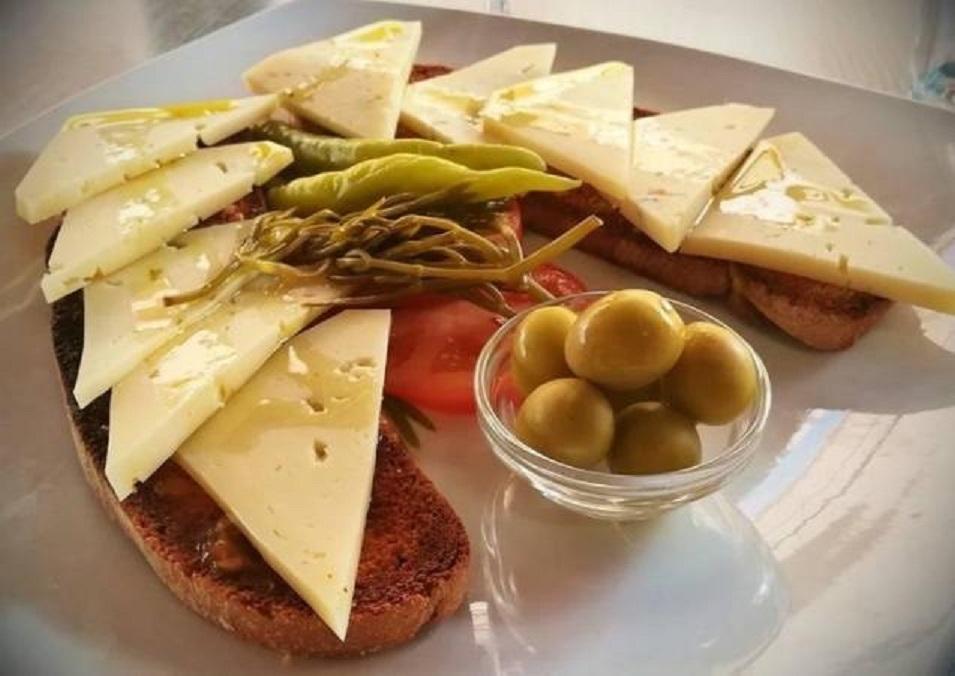Instead, Tomeu replied: “Of course it is. Every time I have a pa amb oli, I eat fast food. ” Spaniards, like many other people, tend to think that fast food is synonymous with junk food. It is not and never has been.
A pa amb oli is the most basic of the culinary delights of the island. It could hardly be simpler: the slices of country bread are rubbed with the soft ramellet tomato, sprinkled with extra virgin olive oil and covered with slices of cheese or Iberian ham.
They should be served with Majorcan bitter green olives called 'trencades' and black ones called 'pans'. A glass of robust red wine is the perfect drink with 'pa amb oli', but white is the most acceptable, as is a glass of cold beer.
You will find 'pa amb oli' in bars, restaurants and cafés throughout the island and there are even places called 'pambolerías' that serve nothing more than 'pa amb oli' with various types of toppings.
You can easily do a very good ‘pa amb oli’ at home — even in England if you use a country wholemeal loaf with a close-textured crumb.
The success of a pa amb oli doesn’t depend on any special culinary techniques and even complete beginners can make a good one. But, as with all simple food, the ingredients must be of the highest quality.
In Majorca you should get the loaf known as ‘pa pagès’ or ‘pa moreno’, ideally from a bakery that makes its own bread.

The Majorcan ‘pa moreno’ is a darkish bread with a close grain that is ideal for soaking up the juices and pulp of the tomato and the olive oil. One of the reasons for making pa amb oli in the old days was to make stale bread more palatable.
Allow two slices of bread per person and put them on a large plate. We are now ready to rub the slices of bread with halves of the ‘ramellet’ tomato which is soft and pulpy and ideal for rubbing on bread. You can buy them loose or in clusters on a string.
Cut the tomato in half through the stalk end, squeeze one piece over the slice of bread and rub it into the surface. Press down on the bread so that you leave behind as much juice and pulp as possible. If one half of tomato isn’t enough to impregnate the bread with juices and pulp, use part of another half. Repeat with the other slices of bread.
You now drizzle the surface with virgen extra olive oil. The amount you use is entirely a matter of personal taste, but you don’t want to overdo it or your ‘pa amb oli’ will be messy to eat, You must use virgen extra olive oil. You really notice the taste of the oil in simple dishes, so the better the oil, the better the pa amb oli.
Once the oil is on the bread you can spread it evenly over the surface with a spent tomato half. Add salt to taste.
A high quality natural salt to use is the Flor de Sal from the salt flats of Es Trenc in the south east of Majorca.

They have been producing Flor de Sal, the purest and finest of all sea salts, for centuries. It is harvested entirely by hand, and dried in the Majorcan sun.
This is the basic pamboli that can be eaten as a snack with the olives mentioned earlier.
However, when it is served as a luncheon or supper dish the addition of protein is called for. The two favourite toppings, which you will come across in bars and restaurants, are slices of Iberian cured ham or cheese, preferably a Majorcan one or a Mahón cheese from Minorca.
Another successful topping is a plain omelette. You can also criss-cross the surface with tinned anchovies or dot it with little clumps of canned tuna. A few capers add a nice tangy touch, but don’t be heavy-handed with them.
Another authentic delight is the Llonguet, a small roll of crusty oval bread easily recognizable by the deep crack in the middle.

The Llonguet is native to Palma and the locals enjoy them for breakfast, lunch and merienda (snack).

Stuffed with sobrasada (a type of raw and cured Majorcan sausage); ham and cheese; mackerel or octopus, llonguet is one of the simplest and most unique culinary snacks in Palma.
For more information visit www.mallorca.es




